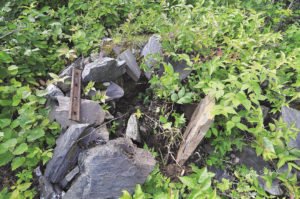What is a ghost town? A simple definition is a “town that no longer has any people living in it,” or as author T. Lindsay Baker (Ghost Towns of Texas) explains, it is, “a town for which the reason for being no longer exists.” In our Northern Wilds area, there are plenty of ghost towns on both sides of the border (some reports put the number at 200-300 ghost towns in Minnesota alone).
In her paper on Northern Minnesota’s Ghost Towns of Cook County, Olga N. Soderberg (then President of the Cook County Historical Society) wrote that the county had “its share of ghost towns,” and they were “…mementos of the iron ore, copper and gold rush days and later lumber-camp days.” She mentions a number of ghost towns, like Cartierville, Rove Lake, Redmyer, Paulson/Paulson Mines, North Cascade, South Cascade, Lockport, Saganga Lake, Saxton, Chippewa City, and Mineral Center.
She writes that “one of the most interesting” is Parkerville, which was located at the mouth of the Pigeon River on the American side, “across Rat Point from Grand Portage.” As the story goes, around 1680, Daniel Greyson Sieur du Luht set up and later abandoned a fur-trading post on the site. Then, from 1795 to 1804, William Parks and others operated a trading post before returning to Grand Portage. In 1836, Walter Parks arrived, established a store, trading post, and post office. He named the place Parkerville. Mail was delivered here weekly by dog team in winter and boat in summer. A savvy entrepreneur with hired staff at times, Parker also sold fish that he caught, fuel wood from timber on his land, and vegetables from the family’s farm.
The Parkers moved in the 1860s to Ontonagon, Michigan, and the store and post office was taken over by a Mr. Jackson. When Jackson left in 1876, Parkerville was abandoned.

The “newest” ghost town in northern Minnesota may well be the former town site of Taconite Harbor, located 33 miles south of Grand Marais and built in the 1950s by Erie Mining for their nearby power plant employees and families. In 1986, LTV Steel acquired Erie, laid off employees, evicted the town’s residents (only 12 remained by November 1987) and moved out houses to dismantle the town. Reports indicate that all that is left now are overgrown paved streets where homes once stood, some streetlights and an abandoned basketball court.
On the Canadian side, just across the international border, is the ghost town of Leeblain, located on a small bay on the North Shore of Gunflint Lake. Largely forgotten until Thunder Bay historian David Battistel began researching the area about 25 years ago, Leeblain—once expected by investors to be a growing metropolis—existed for 10 years, between 1893 and 1903.
Created as a stop on the Port Arthur, Duluth and Western Railway—which was being built between Port Arthur (now Thunder Bay), Gunflint, Ely and eventually Duluth—Leeblain was named after two of the railway’s Toronto investors: A. B. Lee and Hugh Blain. The remote town was expected to grow into a metropolis, a major railway terminus, thanks partly to Paulson Mines just across the Minnesota border. But the mines failed and the railway struggled financially. In 1903, the line to Gunflint Lake and Leeblain was abandoned.
Except for the rail bed and a few rock ovens built by Italian railway workers to bake bread, little remains of Leeblain. Nature has taken back the site, which was further damaged by the 1999 windstorm, logging in 2000 to remove storm’s deadfall and the 2007 Ham Lake fire.
North of Leeblain and connected to the same railway line is the ghost mining village of Silver Mountain; which was a booming place back in the late 19th century. Located at the base of Silver Mountain and abandoned more than a century ago, the foundations of a few West Silver Mountain Mine buildings still exist. However, only a few scattered artifacts remain of the nearby miners’ village, where National Hockey League (NHL) Hockey Hall of Fame’s Jack Walker was born in 1888 (originator of hockey’s “hook-check,” he won three Stanley Cups with three different teams). When touring the site with one of the private owners, we came upon some blossoming apple trees—a reminder of the families that once lived here.
Ghost towns are also scattered across northwestern Ontario and include places like Jackfish, Coldwell, Cameron Falls, Tashota, Allanwater Bridge, Farland, Gold Rock, Osaquan, Burchell Lake, Pickle Crow, Goldpines and Grant.

